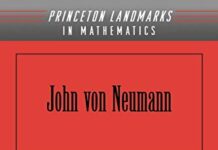
Ebook Info
- Published: 1955
- Number of pages: 464 pages
- Format: PDF
- File Size: 5.33 MB
- Authors: John von Neumann
Description
Mathematical Foundations of Quantum Mechanics was a revolutionary book that caused a sea change in theoretical physics. Here, John von Neumann, one of the leading mathematicians of the twentieth century, shows that great insights in quantum physics can be obtained by exploring the mathematical structure of quantum mechanics. He begins by presenting the theory of Hermitean operators and Hilbert spaces. These provide the framework for transformation theory, which von Neumann regards as the definitive form of quantum mechanics. Using this theory, he attacks with mathematical rigor some of the general problems of quantum theory, such as quantum statistical mechanics as well as measurement processes. Regarded as a tour de force at the time of publication, this book is still indispensable for those interested in the fundamental issues of quantum mechanics.
User’s Reviews
Editorial Reviews: Review “[Von Neumann’s] book was the first exposition of quantum mechanics that made the theory mathematically respectable. The concepts were rigorously defined and the consequences rigorously deduced. . . . From that book I learned most of what I know about quantum mechanics.”—Freeman Dyson, Notices of the American Mathematical Society”That von Neumann has been ‘par excellence’ the mathematician of quantum mechanics is as obvious to every physicist now as it was a quarter of a century ago. Quantum mechanics was very fortunate indeed to attract, in the very first years after its discovery in 1925, the interest of a mathematical genius of von Neumann’s stature. As a result, the mathematical framework of the theory was developed and the formal aspects of its entirely novel rules of interpretation were analyzed by one single man in two years.”—Léon Van Hove, Bulletin of the American Mathematical Society”After almost a quarter of a century this book is still a valuable addition to any library. There are few references in which quantum statistics, including the concept of the density matrix and a discussion of the theory of measurement, is treated in as masterful a manner. . . . [The translator] is to be congratulated on an excellent piece of work.”—M. E. Rose, Physics Today”The translator and publisher have performed a service in making this classic available to a wider circle of English-speaking readers. It remains indispensable to those who desire a rigorous presentation of the foundations of the subject.”—A. F. Stevenson, Quarterly of Applied Mathematics”[W]hat a delight. . . . [I]nsightful, motivated, intuitive and understandable. . . . [A] classic.”—S. Gudder, Mathematical Reviews From the Back Cover Mathematical Foundations of Quantum Mechanics was a revolutionary book that caused a sea change in theoretical physics. Here, John von Neumann, one of the leading mathematicians of the twentieth century, shows that great insights in quantum physics can be obtained by exploring the mathematical structure of quantum mechanics. He begins by presenting the theory of Hermitean operators and Hilbert spaces. These provide the framework for transformation theory, which von Neumann regards as the definitive form of quantum mechanics. Using this theory, he attacks with mathematical rigor some of the general problems of quantum theory, such as quantum statistical mechanics as well as measurement processes. Regarded as a tour de force at the time of publication, this book is still indispensable for those interested in the fundamental issues of quantum mechanics.
Reviews from Amazon users which were colected at the time this book was published on the website:
⭐Here we are, 2018, and only now am I getting to a serious and detailed study of this unique monograph. Unfortunate ! It is unfortunate because I waited too long to study this book in its entirety. To be sure, I had read portions of the text reprinted in the volume of Wheeler and Zurek: Quantum Theory and Measurement (1983). I was misled into believing that von Neumann’s treatise was merely one of injecting mathematical rigor into Dirac’s enterprise. However, that view (of mine) is incorrect. Portions of the text do accomplish that (for example, page 25), but, there is much more to it !(1) Perhaps the most captivating aspects deal with causality (for instance, pages 302, 305, 323, 326, 328). Let us read: “As we see, the attempt to interpret causality as an equality definition led to a question of fact which can and must be answered, and which might conceivably be answered negatively.” Chapter four will explain that statement !(2) The structure of this treatise is interesting: First, physical (chapter one) then, mathematical (chapter two), then an amalgamation of the physical and the mathematical (chapter three), following which, statistical (chapter four) and, finally, measurements (chapters five and six; these two chapters are the pages reprinted in the 1983 Wheeler & Zurek compendium).(3) Now, if you have John von Neumann, you need to study: Dirac, Kramers, Heisenberg, Pauli, and Schrodinger. It is my opinion that in order to appreciate all of these historical documents, you need to compare and contrast each. Previous to commencing, read two articles: London and Baer “The Theory of Observation in Quantum Mechanics (1939),” and Bryce dewitt “Quantum Mechanics and Reality” (1970, Physics Today 23(9):30-35). All are well worth the effort !(4) Not everything herein is difficult (that was another mistaken bias I possessed): For example, von Neumann explicitly shows how he justifies Dirac’s “delta function” with (instead) his “function sequences.” (see: footnote #84, page 128). Another is where we learn that the “trace is invariant” (footnote #113, page 179). So you will see, the more involved details are relegated to the footnotes. That is, the “rigor” which is here does not detract from the lucid exposition.(5) Something which is explicated herein: the interplay between discontinuity and continuity. That is, between discrete and continuous. Or, when the total energy is “known” the time-dependent schrodinger wave-equation is “continuous and causal,” otherwise, confronted with discontinuous, instantaneous, and non-causal. Read: “the chief weakness of quantum mechanics is that it presupposes a simultaneity concept” but, “what we really need is not that the change of t (time) be small, but only that it have little effect in the calculation of probabilities.” (page 354).(6) Probability and Born: “the first statistical statements on the behavior of a system in the ‘state- theta’ originated with Max Born. Also, “although we believe that after specifying the ‘state’ we know the state completely, nevertheless, only statistical statements can be made of the physical quantities involved.” (page 207).(7) Uncertainty Relations: “it will not be clear to common-sense without a further discussion why the position and velocity (coordinate and momentum) of a material body cannot both be measured with arbitrarily high accuracy.Therefore it is necessary to elucidate by an exact analysis… that this is not the case.” (page 238). This, he proceeds to do. This is chapter three, a fine chapter entitled “the quantum statistics.”(8) I conclude my review. In so doing, I apologize to John von Neumann and readers of my review. There is simply too much here that is fascinating and well-written. I have spent many more hours studying the texts and papers of Dirac, Kramers, Heisenberg and Pauli and Schrodinger than anything von Neumann ever wrote. That is a mistake for which I intend to make amends. Get a copy of this fascinating treatise, and study the entirety of it !
⭐John Von Neumann towers as one of the great mathematicians. Said by some to possess skills exceeding normal human capabilities, he was able to contribute to many different areas of science and engineering, including computer systems theory, set theory, functional analysis, and statistics. He also contributed immensely to the field of quantum mechanics.This book represents that immensity. Covering the development of the Transformation Theory and its origin to the Measuring Process, von Neumann is capable of providing the mathematical rigor as well as detailed and easy to understand commentary throughout this important work.The Notes in this work stand out, especially. They are informative and compliment the main text explicitly, expanding it and making it more informative. They often go beyond a simple reference to operate as a subtext of the main text, not to be ignored.Further adding to this point is the fact that von Neumann, throughout this work, continues to give personal commentary: *reasons* for and historical references to, the many mathematical pronouncements and derivations. For instance, on page 196 he begins to develop the statistical assertions of quantum mechanics. By page 198 we have been shown “one of the first and simplest examples by means of which the statistical character of quantum mechanics was recognized.” Not only was the derivation clear and concise, the reader is provided the historical context as well.Often a book of this sort is more a historical document than active reference (unless you are capable of the math). As such, books on quantum mechanics authored by the early founders (and, in this case, a later superb contributor and inventor of notions like “quantum logic”) offer an insider look at the mindset of both the classically trained physicist against what the new physical theory asked of that mind.For instance, this is reflected in a superb Preface, wherein the author states the object of this book (“to present the new quantum mechanics in a unified representation which, so far as it is possible and useful, is mathematically rigorous…what is presumably a definitive form: the so-called “transformation theory.”). We also learn in this Preface that “we shall as a rule omit any discussion of the application of quantum mechanical methods to particular problems, as well as any discussion of special theories derived from the general theory – at least so far as this is possible without endangering the understanding of the general relationships.”He goes on to point out that his mathematical treatment in this work “deviates considerably from that of Dirac.” Thus, he takes Dirac’s “elegant” theory for it “in no way satisfies the requirements of mathematical rigor – not even if these are reduced in a natural and proper fashion to the extent common elsewhere in theoretical physics. For example, the method adheres to the fiction that each self-adjoint operator can be put in diagonal form.”Von Neumann’s solution is to start from the beginning with Hermitean operators and Hilbert spaces which “provide the framework” for the Transformation Theory. This book is that story in the authors own voice.I suggest you purchase a copy for your library today.
⭐The content is timeless and, of course, haven’t finished reading.It was packed in protective shipping material and arrived in perfect condition.
⭐What is hard to imagine is the timeliness of this book’s entrance on the world stage. Heisenberg, Dirac, Born and Schoedinger had all just published the basic elements of Quantum Mechanics. This book provided a unified basis from which all these results could be seen to “hang together”. From this foundation, von Neumann and Murray in a series of amazing articles discovered the theory of operators, leading to von Neumann algebras. Lefschetz had not yet published his book on Topology. von Neumann wrote his own basis for functional analysis (including its topological underspinnings) as lectures at the Institute of Advanced Study in the mid 1930’s, filling a gap few even knew existed until the 1950’s.
⭐This book is a classic. Anyone who is interested in an axiomatic treatment of quantum mechanics should get this book. The only drawback is that it looks like it was typed on a typewriter, so I recommend learning about operator theory from a more modern text with a more readable font. But Neumann’s book is fantastic for its mathematical and physical insights. Most calculations done in the book are with operators that have a discrete spectrum, but it isn’t a big problem. It does deal with continuous spectra in some places though. If you are looking for extensive examples of using unbounded operators with continuous spectra, this book doesn’t have it. But I cannot recommend this book enough.
⭐Bought this as a present for my dad. He is very pleased with the quality of the book and he thinks it’s very well priced compared to what they have to pay for the same in Europe. He also received it within a week after purchasing from the USA .So very satisfied !
⭐It is very rare to meet with such a clear analysis of the topic nowadays. The book has some typographic issues but gives an easier reading compared to the previous edition.
⭐But outrageously expensive for what is essentially an inexpensive cosmetic makeover
⭐Straight into Hilbert space. The algebra is the fount of everything. And it works.You get the feeling that von Neumann just steam-rollerred the whole infant subject into submission.Given who the author is, this is to be expected. It is undoubtedly a magnificent achievement.But the book is clearly a photocopy of a manuscript knocked up on an old fashioned typewriter. The layout is very poor. It even contains hand-written special characters. It is a very poor production for a vast amount of money.I particularly wanted to see his proof that the actual point of measurement is when that measurement sinks into the consciousness. Found it. The logic is impeccable, but I don’t know that I believe it.I had also heard that the concept of “the collapse of the wave function” is due to von Neumann. I did not find that confirmed in this book. But as a wave function is, for von Neumann, only another chance to get straight back into Hilbert space, perhaps he did not invent this concept, after all.This is a historical document – not a book for students or (like me) the casual observer.
⭐First of all, it came without the dust jacket!!! For the price you pay: this is not admisible. Second, the physical; not intelectual, materials are of cheap quality. Why? I can’t understand…Obviously, the problem is not with John Von Neumann works; rather, with the Princeton University Press. The PDF of the book is available everywhere, so I can’t understand why they couldn’t print a decent version of the book.
⭐Mi riferisco alla versione del 1996. Caratteri stile macchina da scrivere. Illeggibile. Ovviamente nulla da ridire sull’opera che risulta un must per ogni appassionato di Meccanica Quantistica
Keywords
Free Download Mathematical Foundations of Quantum Mechanics 1st Edition in PDF format
Mathematical Foundations of Quantum Mechanics 1st Edition PDF Free Download
Download Mathematical Foundations of Quantum Mechanics 1st Edition 1955 PDF Free
Mathematical Foundations of Quantum Mechanics 1st Edition 1955 PDF Free Download
Download Mathematical Foundations of Quantum Mechanics 1st Edition PDF
Free Download Ebook Mathematical Foundations of Quantum Mechanics 1st Edition



